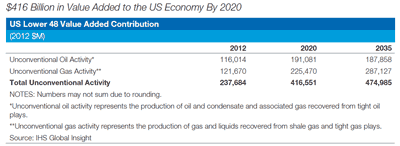 |
April 11, 2013 - Supply Chain Newsletter |
 |
| FEATURED SPONSOR: COMPLIANCE NETWORKS |
 |
Lean Freight Performance Via Timely Freight Post-Audits, Green Benefits, Retail Supply Chain Special Reports and more |
|
|
 |
|
|||||||||||||||||||||||||||||||||||||||||||||||||
Showdown at the US Energy Corral?
|
||||||||||||||||||||||||||||||||||||||||||||||||||
| GILMORE SAYS: |
"Natural gas is running about $4.00 or so per million BTU (British Thermal Unit) in the US. The global price? Multiple times higher, somewhere around $12.00 per mmbtu in Europe, for example, and $15-18.00 for the equivalent liquid natural gas in most of Asia." WHAT DO YOU SAY? |
Regardless of my views, I try to stay out of the politics of these and other matters, stick to the facts and analysis of them with an unbiased presentation - though that is not always easy to do, and never to everyone's satisfaction. Will do my best here to walk that path again, but will say frankly up front I am very much in favor of continued development of US oil and gas resources.
So here we go: over the last few years, new processes, largely "fracking," have led to a dramatic increase in oil and natural gas production in the US, with much more still to come.
Over the past five years, US natural gas production has risen from 52 billion cubic feet (bcf) per day to 65 bcf per day - a 25% increase. This rapid rise was driven primarily by shale gas/fracking production. By the end of the decade, natural gas production will likely reach nearly 80 bcf per day-almost 75% of which will originate from unconventional activity that includes not only shale gas but tight sands formations and coal bed methane. That would represent an increase of about 54% in production versus already strong 2007 levels, according to a recent report from researchers at IHS, led in part by noted energy industry expert Daniel Yergin.
This natural gas production boom led to prices falling to historic lows in the past couple of years - in the US only, not globally. This is very important - more on that in a second.
US oil production until just recently experienced a long period of decline. From 1970 to 2008, US crude oil production fell from 9.6 million barrels a day to just 5 mbd. Now, the same types of techniques developed for natural gas production are being used to produce oil from shale and other sources too. Such unconventional production volumes have increased from 100,000 barrels per day in 2003 to over 2 million barrels per day in 2012 - and volumes are rising rapidly. IHS estimates unconventional oil production in the US will reach almost 4.5 mbd by 2020.
It is hard to overstate the importance to the economy and the supply chain from this major change in the energy landscape.
The economics numbers flowing from this "revolution" are staggering, according to IHS. It expects that more than $5.1 trillion in capital expenditures will take place between 2012 and 2035 in the US across unconventional oil and natural gas activity, of which:
• Over $2.1 trillion in capital expenditures will take place between 2012 and 2035 in unconventional oil activity.
• Close to $3.0 trillion in capital expenditures will take place between 2012 and 2035 in unconventional natural gas activity.
These are huge numbers.
In addition:
• Employment attributed to upstream unconventional oil and natural gas activity will support more than 1.7 million jobs in 2012, growing to some 2.5 million jobs in 2015, 3 million jobs in 2020, and 3.5 million jobs in 2035.
• On average, direct employment will represent about 20% of all jobs resulting from unconventional oil and natural gas activity, with the balance contributed by indirect (e.g., metal pipes) and induced (e.g., housing construction) employment.
If you are looking for a job, by the way, head to North Dakota, where there is major oil and gas production going on. Its unemployment rate is just 3.3%, the lowest in the nation.
As shown in the chart below, from the IHS report, this unconventional activity is expected to produce $416 billion in "value added" to the US economy by 2020 just from the production activities and investments alone, not including all the indirect activity. That is a huge number, and will help significantly lift overall US GDP.

There's more. As we reported earlier this year, cheap and abundant natural gas is driving a US manufacturing renaissance in sectors that use a lot of nat gas either as a raw material or as production fuel. That includes chemicals, fertilizers, metals, paper, glass and more. "Rust belt" areas of the Midwest are seeing many announcements about major new plants or expansions, including the first new US fertilizer plant in 20 years and several major new chemical facilities.
Here is why: natural gas is running about $4.00 or so per million BTU (British Thermal Unit) in the US. The global price? Multiple times higher, somewhere around $12.00 per mmbtu in Europe, for example, and $15-18.00 for the equivalent liquid natural gas in most of Asia. This is a staggering advantage for US manufacturers in many sectors - and why many of them are now expanding here.
Besides that supply chain impact, the effects on the logistics industry are likely to be huge. I agree with T. Boone Pickens, who says we are likely see to widespread adoption of natural gas-based truck engines in the next 4-8 years, with that range dependent in part on what the government does in terms of loans.
First, this likely to reduce operating costs substantially (yes, natural gas prices could skyrocket and erase this advantage, I suppose, but Pickens says once the price reaches $5.00, it will bring out many more producers and create large supplies). It will reduce CO2 emissions by around 25% per mile driven, and spur lots of jobs and activity making the new trucks. As we reported just a few weeks ago, the rail carriers are also starting to look at natural gas powered engines.
Finally, many believe the US is on a path from all this to true energy independence. US oil production is expected to exceed oil imports in 2013 for the first time since 1995. Every dollar not spent on foreign oil is a dollar not subtracted from GDP, the way the calculations work. While true energy independence may not come fully or even be desirable, obviously having the US mostly reliant on domestic sources would have a significant impact on the economy, security, foreign policy and more.
Now we have to get a little political, but I believe fairly. Something like all the good things I have described above is going to happen - unless the government tries to slam on the brakes, or at least hit them pretty hard. That the Obama administration has still not approved the Keystone pipeline project I believe is telling - this seems like a no-brainer to me. The energy boom is going to require thousands of more miles of pipe. New York's governor continues to block fracking in his shale gas-rich state.
There is a lot more to note on these real and potential government barriers, but I am unfortunately out of space. You may believe the risks of global warming and the US' role in it are worth roadblocks set up to thwart the US energy boom, as obviously many environmentalists do. To what extent will the current administration try put up those obstacles? That is the multi-trillion dollar question.
Maybe public policy can walk the fine line between reducing use of oil and natural gas generally in favor of renewable or low carbon energy sources while still encouraging US domestic energy production. Or is this idea a contradiction to begin with? Does it have to be one way or the other? This is my point. I think largely Yes.
How this energy show down plays out will be of significant historical import. I will end with this: we have a major competitive advantage in natural gas - and absolutely none in solar panels. I like solar panels too, but we're the Saudi Arabia of natural gas.
Do you think the explosion in US energy production can transform the economy and supply chains? Do you see a looming show down between US domestic energy production and the anti-fossil fuel forces? Let us know your thoughts at the Feedback button below.
![]()
| View Web/Printable Version of this Page |
|
|
|
YOUR FEEDBACK
We received a good number of short but complimentary emails on our First Thoughts column last week on LaHowchic, Cantwell, Tyndall - Unplugged Redux, which as part of our 10th anniversary recognition in 2013 at SCDigest featured some snippets from some of the best of our popular "Unplugged" interview series with supply chain though leaders over the years.
Most were of the "this was very interesting variety," and we appreciate those very much, with in some cases some pithy observations on the content. If you missed last week's column, we recommend you take a look this week at the link above.
A sample of these emails below - including one from Nick LaHowchic himself.
Feedback Thought Leaders Unplugged Redux
I was surprised to see my name in big letters when I opened SCDigest. Thanks for including me with other great professionals. On reflecting on all three short pieces I still believe that both the availability and proper use of full channel real-time information, along with superior behavioral skills that collaborate cross organizational teams, are a basic requirement to excel in today's business environment. I continue to enjoy seeing and reading what you have to say about the evolving profession. Nick LaHowchic |
||
I really like Gene Tyndall's comments and now that I'm sitting his seat, I can see that the OCM [organizational change management] side of the equation is the biggest roadblock to true transformation. If you can't get the executives, middle management and users to adopt, it doesn't matter how good your software is.
|
||
| Enjoyed the excerpts from the Unplugged Interviews - short, quick and informative reads. Good perspectives on current Supply Chain topics.
Ed Bowersox |
||
| First and foremost, congrats on your 10-year anniversary! An outstanding accomplishment!
Lisa F. Danahy |
||
| I think these are very valuable inputs. It give you a transparency how investment in supply chain give return in long run. It also show the important of technology implementation in supply chain. In fast growing industries you need a very dynamic supply chain team and tools.
|
||
| I really like the "Unplugged" piece. And I am looking forward to the Eli Goldratt piece. Joe Elledge |
SUPPLY CHAIN TRIVIA ANSWER
Q: What are the top ten trading partner countries (imports plus exports) of the US, based on 2012 data?
A: (1) Canada (2) China (3) Mexico (4) Japan (5) Germany (6) UK (7) South Korea (8) Brazil (9) Saudi Arabia (10) France.
| © SupplyChainDigest™ 2003-2013. All Rights Reserved. SupplyChainDigest PO Box 714 Springboro, Ohio 45066 |
POWERED BY: XDIMENSION
|









